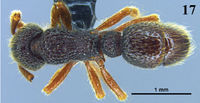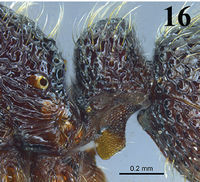Stictoponera quadrutinodules
| Stictoponera quadrutinodules | |
|---|---|

| |
| Scientific classification | |
| Kingdom: | Animalia |
| Phylum: | Arthropoda |
| Class: | Insecta |
| Order: | Hymenoptera |
| Family: | Formicidae |
| Subfamily: | Ectatomminae |
| Tribe: | Ectatommini |
| Genus: | Stictoponera |
| Species: | S. quadrutinodules |
| Binomial name | |
| Stictoponera quadrutinodules (Chen, Lattke & Zhou, 2017) | |
This species has been found nesting under a stone in broadleaf forest and conifer mixed forest at the altitude of 1026 m.
Identification
Chen et al. (2017) - The workers of Stictoponera quadrutinodules are distinguished from workers of other species of Stictoponera by the combination of the following characters: small eye, with 5 ommatidia along the maximum diameter; occipital lamella of head of head narrow and inconspicuous; petiole with anterior corner slight rounded and posterior corner bluntly angulate, node roughly sub-quadrate with dorsal and anterior margins weakly convex, posterior margin straight. Subpetiolar process sub-quadrate.
The workers of S. quadrutinodules are quite similar to those of Stictoponera coccina and Stictoponera taivanensis. Stictoponera quadrutinodules can be distinguished from S. taivanensis by the rough rugose-punctate sculpturing of abdominal tergite III vs the diminished sculpturing on S. quadrutinodules, the shape of subpetiolar process seems different in the two species and the general color pattern for the workers also seems different.
However, the worker of S. quadrutinodules is distinguished from workers of S. coccina by the following characters: Promesonotal suture ambiguous; 3–7 flagellar segments broader than long; in lateral view petiole roughly sub-quadrate, in dorsal view petiole broader than long; subpetiolar process sub-quadrate.
Keys including this Species
Distribution
Distribution based on Regional Taxon Lists
Palaearctic Region: China (type locality).
Distribution based on AntMaps
Distribution based on AntWeb specimens
Check data from AntWeb
Countries Occupied
| Number of countries occupied by this species based on AntWiki Regional Taxon Lists. In general, fewer countries occupied indicates a narrower range, while more countries indicates a more widespread species. |

|
Estimated Abundance
| Relative abundance based on number of AntMaps records per species (this species within the purple bar). Fewer records (to the left) indicates a less abundant/encountered species while more records (to the right) indicates more abundant/encountered species. |

|
Biology
The specimens were found nesting under a stone in broadleaf forest and conifer mixed forest at the altitude of 1026 m.
Castes
Nomenclature
The following information is derived from Barry Bolton's Online Catalogue of the Ants of the World.
- quadrutinodules. Gnamptogenys quadrutinodules Chen, Lattke & Zhou, in Chen, et al. 2017: 102, figs. 15-28 (w.q.m.) CHINA (Jianxi).
- Type-material: holotype worker, 2 paratype workers, 1 paratype queen, 1 paratype male.
- Type-locality: holotype China: Jianxi, Guangfeng County, Tongbo Mt, 28°05’35’’N, 118°14’20’’E, 1026 m., 2.ix.2012, no. G120081 (C. Lu); paratypes with same data.
- Type-depository: GNUC.
- Combination in Stictoponera: Camacho, Franco, Branstetter, et al. 2022: 12.
- Status as species: Camacho, Franco, Branstetter, et al. 2022: 12.
- Distribution: China.
Unless otherwise noted the text for the remainder of this section is reported from the publication that includes the original description.
Description
Worker
Holotype. TL 4.22, HL 1.05, HW 0.86, CI 82, SL 0.73, SI 84, ED 0.08, PW 0.71, MSL 1.31, PL 0.25, PH 0.61, DPW 0.50, LPI 244, DPI 200. In full-face view head rectangular, distinctly longer than broad, posterior margin almost straight, posterior corner nearly right-angular, lateral margin slightly convex. Mandible triangular, masticatory margin crenulate. Anterior margin of clypeus with convex to bluntly pointed median lobe. Antennal scape just reaching posterior corner of head, flagellar segments 3–7 broader than long. Eye very small, with 5 ommatidia along maximum diameter, situated on the midpoint of lateral cephalic margin.
In lateral view occipital lamella of head narrow and inconspicuous; dorsum of mesosoma moderately convex; promesonotal suture obvious. Propodeum with short triangular denticle; propodeal declivity longitudinally weakly concave, laterally with margin. Petiole roughly sub-quadrate, about 1.7 times higher than long, anterior corner slightly rounded, posterior corner bluntly angulate, dorsal and anterior margin weakly convex, posterior margin straight. Subpetiolar process subquadrate. Sting extruding.
In dorsal view humeral angle rounded; promesonotal suture visible; metanotal groove absent. In dorsal view petiolar node with approximate semicircular anterolateral margin, anterior margin convex and separated from lateral margin by weak blunt angle, lateral margin weakly convergent posteriorly, each margin weakly convex; posterior margin weakly concave; node about 1.5 times as long as broad; anterior petiolar corner rounded, posterior corner blunt.
Mandibular dorsum and clypeus with longitudinal fine striate; space between frontal carinae with four longitudinal striae, rest of head partly rugulose-foveolate; pronotum, propodeum, petiole and anterior two-thirds of third abdominal tergite rugulose-foveolate; middle part of mesonotum with four longitudinal striae; propleuron, mesopleuron and metapleuron irregularly rugulose; dorsum of fourth abdominal tergite smooth, sides with fine short rugulae; propodeal declivity reticulate-rugose. Head, mesosoma, petiole, and gaster with abundant sub-erect hairs. Scape and tibiae with sparse sub-decumbent hairs. Head, mesosoma and petiole black-brown; mandible, antenna, gaster and legs reddish-brown.
Paratype (n = 2). TL 4.18–4.23, HL 1.02–1.06, HW 0.84–0.87, CI 80–83, SL 0.71–0.74, SI 82–85, ED 0.08–0.09, PW 0.70–0.73, MSL 1.30–1032, PL 0.23– 0.26, PH 0.61–0.63, DPW 0.48–0.51, LPI 243–245, DPI 198–202. As the holotype.
Queen
Paratype. TL 5.52, HL 1.21, HW 0.96, CI 79, SL 0.81, SI 84, ED 0.21, PW 0.96, MSL 1.61, PL 0.25, PH 0.72, DPW 0.42, LPI 288, DPI 168. In full-face view head rectangular, longer than broad, middle of posterior margin weakly concave, posterior corner bluntly angular, lateral margin weakly convex. Three ocelli on vertex (two lateral and one median). Mandible triangular, masticatory margin crenulate. Anterior margin of clypeus with convex to bluntly pointed median lobe. Antennal scape almost reaching posterior corner of head. Eye large, more than 20 ommatidia present along maximum diameter, situated on midpoint of lateral cephalic margin.
In lateral view occipital lamella of head narrow and inconspicuous. Dorsum of mesosoma moderately convex. Promesonotal suture obvious; propodeum with short triangular denticle; propodeal declivity weakly concave. In lateral view petiole trapezoid, anterior corner slight rounded, posterior corner angulate, dorsal margin weakly convex, anterior and posterior margins straight. Subpetiolar process sub-quadrate. Sting extruding.
In dorsal view pronotal anterolateral corner rounded. Metanotal groove distinct. Petiole relatively thick, anterior margin slightly convex.
Forewing and hindwing of queen as shown in Figs.
Mandible dorsum, gena and clypeus with longitudinal fine striae; head, pronotum, propodeum, propleuron and petiole coarsely rugulose; mesonotum with longitudinal striae; mesopleuron and metapleuron longitudinally rugulose; third abdominal tergite rugulose-punctate; fourth abdominal tergite with scattered piligerous punctures; declivity transversely striate. Head, mesosoma, petiolar node and gaster with abundant sub-erect hairs; scape and tibiae with sparse sub-decumbent hairs and dense decumbent pubescence. Whole body reddish-brown.
Male
Paratype. TL 4.73, HL 0.85, HW 0.76, CI 89, SL 0.21, SI 27, ED 0.36, PW 0.82, MSL 1.61, PL 0.45, PH 0.33, DPW 0.36, LPI 73, DPI 80. In full-face view head oval. Eyes large, maximum diameter about 0.35mm, occupying about half of lateral cephalic margin, situated on midpoint of lateral cephalic margin. Three ocelli on vertex (two lateral and one median). Frontal carina short. Mandible triangular, masticatory margin with many small teeth; anterior margin of clypeus broadly rounded. Antennal scape short, just reaching anterior margin of median ocellus.
In lateral view posterior carinae of head conspicuous. Mesoscutellum higher than mesoscutum; mesopleural oblique furrow distinctly wide. Propodeal lobe bluntly tri-angular; dorsum of propodeum as long as declivity, posterodorsal corner inconspicuous. Petiole elongated oval; subpetiolar process shaped as rounded translucent lamella.
In dorsal view mesosoma spindle-shaped. Parapsidal sulcus and notaulus present, notaulus conspicuous. Metanotum small, not reaching to the lateral margins. Petiole trapezoidal, anterior margin slightly convex, posterior margin straight, anterior corners rounded.
Forewing and hindwing of male as shown in Figs.
Mandibular dorsum and declivity of propodeum longitudinally finely striate; head, metapleuron and petiole irregularly finely rugulose; pronotum, propleuron, mesopleuron smooth; anterior margin of first gastral tergite with short striae; declivity longitudinally striate. Head and mesosoma with abundant sub-erect hairs, petiole and gaster sparse sub-decumbent hairs and decumbent pubescence; scape and tibiae with sparse sub-decumbent hairs and dense decumbent pubescence. Whole body black-brown.
Type Material
Holotype worker. China: Jianxi, Guangfeng County, Tongbo Mountain, 28°05'35"N, 118°14'20"E, 1026m, 2.IX.2012, leg. Chunwen Lu, No. G120081. Paratypes. 2 workers, 1 male and 1 queen, data the same as holotype. The holotype and paratypes are deposited in the Insect Collection, Guangxi Normal University, Guilin, China (Guangxi Normal University).
Etymology
This species is named from the Latin words “quadrat” (quadrate) and “nodules” (petiole), referring to its nearly square petiole.
References
- Camacho, G.P., Franco, W., Branstetter, M.G., Pie, M.R., Longino, J.T., Schultz, T.R., Feitosa, R.M. 2022. UCE phylogenomics resolves major relationships among Ectaheteromorph ants (Hymenoptera: Formicidae: Ectatomminae, Heteroponerinae): A new classification for the subfamilies and the description of a new genus. Insect Systematics and Diversity 6(1): 5; 1–20 (doi:10.1093/isd/ixab026).
- Cantone S. 2018. Winged Ants, The queen. Dichotomous key to genera of winged female ants in the World. The Wings of Ants: morphological and systematic relationships (self-published).
- Chen, Z., Lattke, J.E., Shi, F., Zhou, S. 2017. Three new species of the genus Gnamptogenys (Hymenoptera, Formicidae) from southern China with a key to the known Chinese species. Journal of Hymenoptera Research 54: 93–112 (doi: 10.3897/jhr.54.10816).
- Liu, C., Fischer, G., Hita Garcia, F., Yamane, S., Liu, Q., Peng, Y.Q., Economo, E.P., Guénard, B., Pierce, N.E. 2020. Ants of the Hengduan Mountains: a new altitudinal survey and updated checklist for Yunnan Province highlight an understudied insect biodiversity hotspot. ZooKeys 978, 1–171 (doi:10.3897/zookeys.978.55767).
References based on Global Ant Biodiversity Informatics
- Chen Z., J. E. Lattke, F. Shi, and S. Zhou. 2017. Three new species of the genus Gnamptogenys (Hymenoptera, Formicidae) from southern China with a key to the known Chinese species. Journal of Hymenoptera Research 54: 93-112.
- Skarbek C. J., M. Noack, H. Bruelheide, W. Hardtle, G. von Oheimb, T. Scholten, S. Seitz, M. Staab. 2019. A tale of scale: plot but not neighbourhood tree diversity increases leaf litter ant diversity. Journal of Animal Ecology DOI: 10.1111/1365-2656.13115


